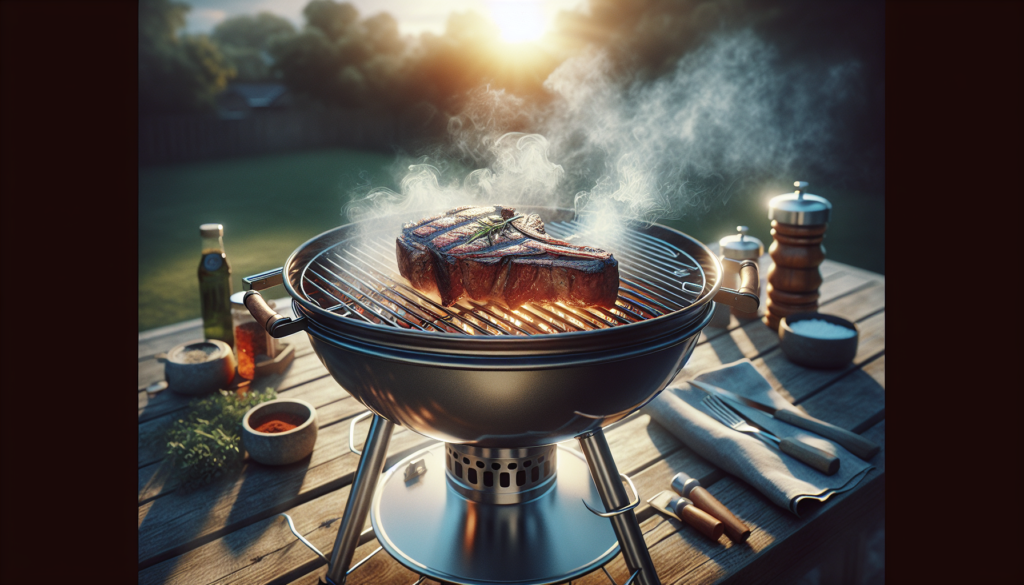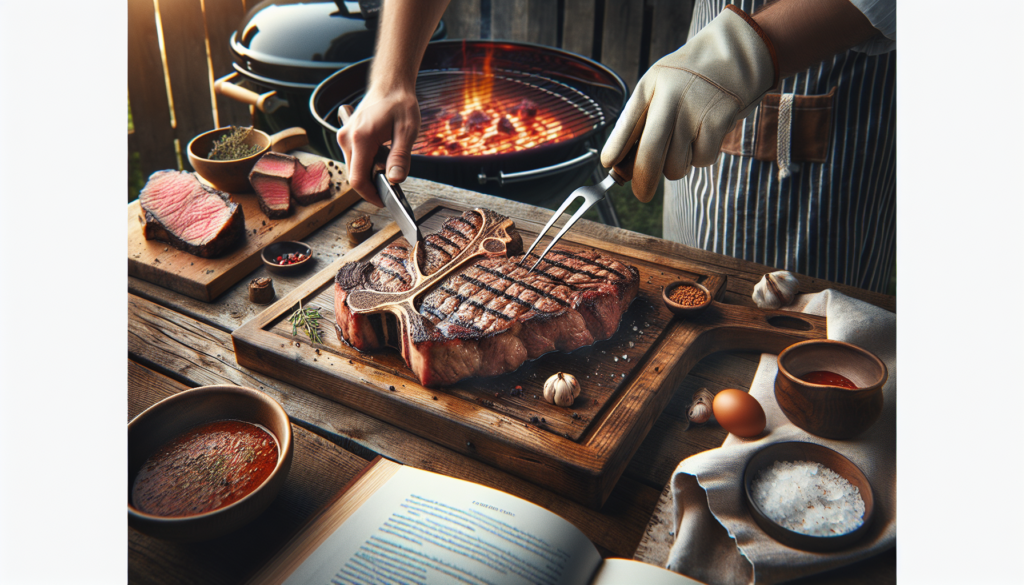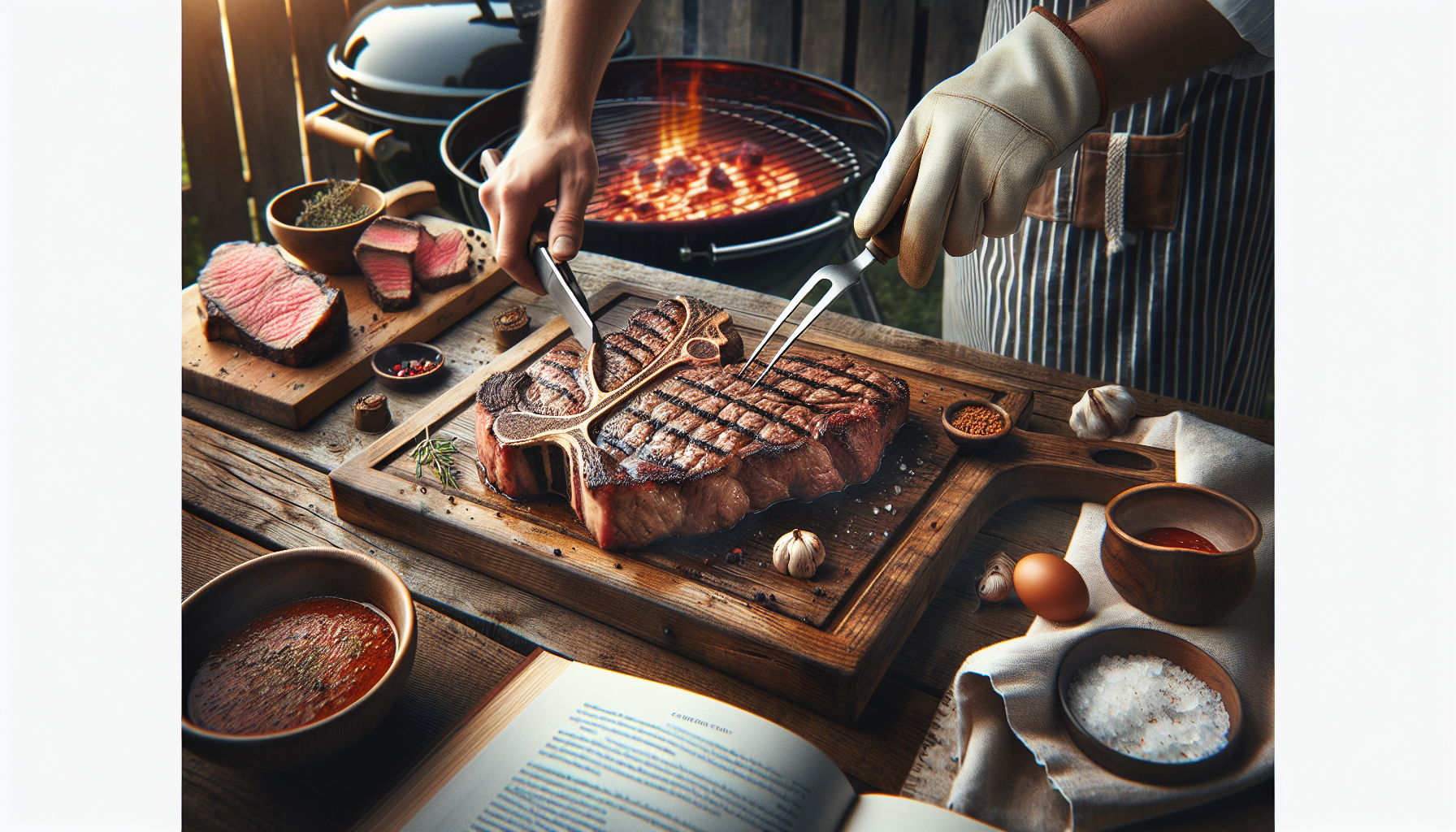Get ready to master the art of grilling steak with these essential tips and tricks. Whether you’re a seasoned grill master or a novice looking to impress, this article will provide you with all the knowledge you need to cook a perfectly grilled steak every time. From selecting the right cut of meat to achieving the perfect level of doneness, you’ll uncover the secrets to creating a truly mouthwatering steak. So grab your apron and fire up the grill, because it’s time to take your steak game to the next level.

Choosing the Right Steak
When it comes to grilling the perfect steak, one of the most important factors to consider is choosing the right cut of meat. Different cuts offer different flavors and textures, so it’s essential to select one that suits your preferences. Some popular options include ribeye, filet mignon, New York strip, and sirloin.
Consider the Cut
Each cut of steak has its own characteristics that can impact the overall taste and tenderness. For example, ribeye is known for its rich marbling, which adds flavor and juiciness to the meat. On the other hand, filet mignon is incredibly tender but lacks the fattiness of cuts like ribeye. Consider what qualities you value most in a steak and choose accordingly.
Look for Marbling
Marbling refers to the thin lines of fat that are interspersed throughout the meat. While it may not be the healthiest aspect of steak, marbling plays a crucial role in determining its taste and tenderness. The fat melts during cooking, enhancing the flavor and moisture of the steak. Look for cuts with even marbling distribution for the best results.
Grass-Fed vs. Grain-Fed
Another factor to consider when choosing a steak is whether it is grass-fed or grain-fed. Grass-fed beef comes from cows that have been raised grazing on grass, resulting in leaner meat with a more distinct flavor. Grain-fed beef, on the other hand, comes from cows that have been fed a diet of grains like corn, which gives the meat a milder taste and more marbling. Think about which flavor profile you prefer.
Thickness Matters
The thickness of your steak will greatly influence the cooking time and the final result. Thicker cuts generally require more time on the grill to reach the desired level of doneness. They also tend to retain their juiciness better than thinner cuts. However, thin cuts can be great for quick cooking methods like searing. Consider what type of grilling technique you plan to use and choose a steak thickness accordingly.
Preparation
Preparing your steak before it hits the grill is just as important as the cooking process itself. Taking the time to properly prepare your steak will ensure that it is flavorful, tender, and juicy.
Remove the Steak from Refrigerator
Before you begin seasoning your steak, it’s essential to remove it from the refrigerator and let it come to room temperature. Allowing the meat to rest at room temperature for about 30 minutes before grilling helps it cook more evenly and ensures that it stays tender and juicy.
Seasoning Options
When it comes to seasoning your steak, there are several options to consider. This step is essential as it enhances the natural flavors of the meat and adds an extra layer of taste.
Salt and Pepper Method
The most classic and straightforward approach to seasoning a steak is simply using salt and pepper. Liberally sprinkle both sides of the steak with kosher salt and freshly ground black pepper. These simple seasonings will bring out the natural flavors of the meat without overpowering it.
Marinades and Rubs
Marinades and rubs are another way to add flavor to your steak. Marinades typically consist of a combination of oil, acid (such as citrus juice or vinegar), and seasonings. They penetrate the meat and infuse it with a delicious blend of flavors. On the other hand, rubs are a mixture of herbs, spices, and other ingredients that are applied directly to the surface of the steak. They create a flavorful crust during the grilling process.
Room Temperature Rest
After seasoning, it’s essential to let your steak rest at room temperature for another 10 to 15 minutes. This rest allows the flavors to meld together and ensures that the meat cooks evenly. During this time, you can also prepare your grill, so everything is ready to go once the steak is rested.
Trimming Excess Fat
While fat is an essential component of a delicious steak, too much excess fat can cause flare-ups and uneven cooking. Take a moment to trim any large pieces of visible fat from the steak. Leaving a thin layer of fat can help enhance the flavor and juiciness without causing any issues during grilling.
Grilling Equipment
Having the right equipment is crucial for achieving the perfect grilled steak. From choosing the right grill to selecting the appropriate accessories, it’s important to make informed decisions to enhance your grilling experience.
Choose the Right Grill
The type of grill you use will greatly impact the flavor and texture of your steak. Some popular options include charcoal grills, gas grills, and electric grills. Charcoal grills provide a smoky flavor and allow for precise temperature control. Gas grills offer convenience and quick heat-up times. Electric grills are perfect for indoor grilling and are easy to clean. Consider your preferences and the space you have available when selecting a grill.
Direct vs. Indirect Heat
Understanding the difference between direct and indirect heat is essential for achieving the desired level of doneness. Direct heat involves placing the steak directly over the heat source, resulting in a quicker cooking time and more visible grill marks. Indirect heat, on the other hand, involves placing the steak away from the heat source, allowing for slower, more even cooking.
Charcoal vs. Gas
The debate between charcoal and gas grills is a common one among grilling enthusiasts. Each has its own advantages and disadvantages. Charcoal grills provide a smoky flavor that many people love, but they require more time and effort to set up and maintain a consistent temperature. Gas grills, on the other hand, are more convenient, with precise temperature control, but may lack the smoky flavor. Consider your priorities and preferences when making this decision.
Temperature Control
Maintaining the right temperature throughout the grilling process is crucial for achieving the perfect steak. Invest in a quality grill thermometer to ensure accuracy. Consult a grilling guide to determine the ideal temperature range for your desired level of doneness. Remember to monitor the grill temperature during cooking and make adjustments as necessary.
Grill Accessories
Having the right accessories can make the grilling process much more enjoyable and efficient. Some essential accessories to consider include grill tongs, spatulas, meat thermometers, grill brushes for cleaning, and a solid grill cover to protect your equipment from the elements. These tools will help you achieve a well-cooked and safely prepared steak.
Cleaning and Maintenance
Proper cleaning and maintenance of your grill are essential for its longevity and functionality. After each grilling session, brush the grates to remove any leftover food debris. Regularly deep clean your grill to prevent the buildup of grease and carbon deposits. Refer to the manufacturer’s instructions for specific cleaning recommendations. By taking good care of your grill, you’ll ensure that it continues to provide excellent grilling results.
Grilling Techniques
Mastering the art of grilling steak involves understanding and applying various grilling techniques. From preheating the grill to nailing the perfect sear, each technique adds to the overall taste and presentation of the steak.
Preheating the Grill
Before placing the steak on the grill, it’s crucial to preheat the grill to the appropriate temperature. This allows the steak to cook evenly and ensures proper searing. Different cuts and thicknesses of steak may require slightly different preheating times, so consult a grilling guide or recipe for specific recommendations.
Oil the Grates
To prevent sticking and ensure beautiful grill marks, it’s important to oil the grates before placing the steak on them. Dip a folded paper towel in vegetable oil or use a non-stick cooking spray to lightly coat the grates. This step will help achieve a nice caramelized crust on the steak.
Direct vs. Indirect Grilling
As mentioned earlier, direct and indirect grilling techniques produce different results. Direct grilling is ideal for thinner cuts or when you want a quick sear. Place the steak directly over the heat source and cook for a shorter period of time. Indirect grilling is better suited for thicker cuts and allows for slower, more even cooking. Place the steak away from the heat source and cook using indirect heat until it reaches the desired level of doneness.
Searing
Searing is the process of cooking the steak over high heat initially to develop a flavorful crust. This technique creates an enticing aroma and enhances the overall taste of the steak. To achieve a perfect sear, make sure the grill grates are hot, and leave the steak untouched for a few minutes on each side. This will allow the Maillard reaction to occur, resulting in a beautiful brown crust.
Reverse Searing
Reverse searing is an alternative technique that involves cooking the steak slowly at a low temperature first, then finishing it off with a quick sear on high heat. This method allows for even cooking throughout the steak and can result in a more tender and juicy final product. It’s especially useful for thicker cuts of steak.
Using a Meat Thermometer
While experience can play a role in determining the doneness of a steak, using a meat thermometer is the most reliable way to achieve the perfect level of doneness. Different cuts and thicknesses of steak will have specific temperature ranges for rare, medium-rare, medium, and well-done. Insert the thermometer into the thickest part of the steak to get an accurate reading.
Grilling Times and Temperatures
Knowing the appropriate grilling times and temperatures for different cuts of steak is key to achieving the desired level of doneness. Rare steaks typically require less time on the grill at a lower temperature, while well-done steaks need more time at a higher temperature. Refer to a grilling guide or recipe for specific recommendations based on the steak cut and thickness.
Resting the Steak
After grilling, it’s important to let the steak rest before slicing and serving. Resting allows the juices to redistribute, resulting in a more tender and flavorful steak. Place the cooked steak on a cutting board and tent it loosely with foil. Let it rest for about 5 to 10 minutes before cutting into it.
Accompaniments and Sauces
Finding the perfect accompaniments and sauces can elevate the flavor and enjoyment of your grilled steak. Here are some ideas to consider:
Classic Steakhouse Sides
Classic steakhouse sides like mashed potatoes, creamed spinach, roasted vegetables, and garlic bread make excellent additions to a grilled steak. These sides complement the flavors of the steak while adding variety and texture to the meal.
Marinades and Sauce Pairings
Experimenting with different marinades and sauce pairings can take your steak to the next level. For example, a tangy chimichurri sauce pairs well with grilled ribeye, while a rich and creamy peppercorn sauce complements filet mignon. Consider the flavor profiles of the marinades and sauces you choose and how they will enhance the taste of the steak.
Compound Butters
Compound butters are a simple yet incredibly flavorful addition to grilled steak. These are made by combining softened butter with herbs, spices, or other ingredients like garlic or blue cheese. Once mixed, the butter is rolled into a log and chilled. When ready to serve, slice a pat of the compound butter and place it on top of the hot steak. As it melts, it adds a burst of extra flavor.

Easy Homemade Sauces
If you prefer homemade sauces, there are countless recipes available that are easy to make and incredibly tasty. From a classic béarnaise sauce to a tangy barbecue sauce, you can find a recipe that suits your taste preferences and complements your grilled steak. Making your own sauces allows you to customize the flavors and experiment with different ingredients.
Troubleshooting
Grilling steak can sometimes be a bit tricky, but with the right knowledge and tools, you can overcome common challenges. Here are some troubleshooting tips to help you navigate any issues that may arise.
Avoiding Flare-Ups
Flare-ups occur when the fat from the steak drips onto the flames, causing sudden bursts of flames. These can result in uneven cooking and even burnt spots on the steak. To avoid flare-ups, trim excess fat from the steak before grilling, keep a spray bottle of water nearby to quickly extinguish any flames, and cook with indirect heat when necessary.
Preventing Stickiness
Steak can sometimes stick to the grill grates, making it difficult to flip and potentially resulting in a loss of crust. To prevent sticking, make sure the grill grates are clean and well-oiled before cooking. Avoid flipping the steak too early; it should release easily from the grates once a crust has formed.
Dealing with Uneven Heat
Uneven heat can lead to overcooked or undercooked spots on the steak. To combat this issue, make sure the grill is properly preheated and that the heat is evenly distributed. If your grill has hot spots, adjust the positioning of the steak during cooking. You can also use indirect heat to ensure more even cooking.
Overcooking or Undercooking
One of the most common mistakes when grilling steak is overcooking or undercooking it. Overcooked steak can become tough and dry, while undercooked steak may not be safe to eat. Using a meat thermometer is the most foolproof way to achieve the desired level of doneness. Refer to grilling guides or recipes for specific temperatures, and always test the doneness of the steak before removing it from the grill.
Achieving Desired Doneness
Different people have different preferences when it comes to the level of doneness in their steak. Whether you like it rare, medium-rare, medium, or well-done, it’s crucial to know the desired internal temperature for each level. Use a meat thermometer to ensure accuracy and measure the temperature in the thickest part of the steak.
Serving and Presentation
The final step in the journey to the perfect grilled steak is serving it in a way that enhances the overall dining experience. From plating the steak to choosing the right garnishes and accompaniments, attention to detail can make all the difference.
Plating the Steak
When plating a grilled steak, consider the visual appeal and presentation. Arrange the steak on a clean plate, and if desired, place it on a bed of mixed greens or roasted vegetables for added color and texture. Be mindful of how the steak is positioned on the plate to make it visually appealing.
Slicing and Serving
Before slicing the steak, take a moment to appreciate the aroma and visual appeal of the perfectly cooked piece of meat. Use a sharp knife to cut the steak against the grain into thin slices. This will help ensure tenderness and make it easier to eat. Serve the slices on warmed plates to keep the steak at an ideal temperature.
Garnishing Ideas
Garnishes can add a touch of elegance and additional flavor to your grilled steak. Consider topping the steak with freshly chopped herbs like parsley or cilantro, or sprinkle some crumbled cheese or bacon bits over the top. These small additions can elevate the overall presentation and taste.
Pairing with Wine or Beer
Pairing your grilled steak with the right wine or beer can enhance the dining experience. Red wines like Cabernet Sauvignon or Malbec are classic choices that complement the richness of a grilled steak. If you prefer beer, opt for a full-bodied and slightly hoppy brew like an IPA or a porter. Experiment with different pairings to find your favorite combination.
Grilled Steak Recipes
If you’re looking for inspiration or want to try something different, there’s no shortage of delicious grilled steak recipes available. From traditional favorites like steak fajitas or surf and turf to more adventurous options like balsamic-glazed steak skewers or Asian-inspired marinated steak, the possibilities are endless. Explore different recipes and techniques to expand your grilling repertoire.
Variations and Experimentation
Grilling steak is an art, and part of the fun is in experimenting with different techniques and flavors. Don’t be afraid to try new cuts of steak, marinade combinations, spice rub mixes, and grilling techniques. Each experiment will teach you something new and bring you closer to becoming a master of grilled steak.
Different Cuts of Steak
Explore various cuts of steak to discover their unique flavors and textures. From the tender filet mignon to the flavorful T-bone, each cut offers a distinct grilling experience. Research recipes and cooking methods specific to each cut to maximize their potential.
Marinade Combinations
Marinades are a great way to infuse your steak with incredible flavor. Experiment with different combinations of oils, acids, herbs, and spices to create unique flavor profiles. Consider Mediterranean-inspired marinades with olive oil, garlic, and lemon, or Asian-inspired marinades with soy sauce, ginger, and chili.
Spice Rub Mixes
Spice rubs can enhance the taste of your grilled steak and add a delicious crust. Experiment with different spice blends, such as a classic steak seasoning with salt, black pepper, and garlic powder, or a spicy Cajun rub with paprika, cayenne pepper, and thyme. Adjust the spice levels to suit your taste preferences.
Grilling Techniques from Around the World
Grilling techniques vary across different cultures, and exploring these techniques can open up a world of flavors. Consider trying Brazilian-style picanha, Argentinian-style chimichurri, or Korean-style bulgogi. Each technique brings its own unique flavors and grilling methods.
Tips for the Best Grilled Steak
To ensure a successful grilling experience, here are some additional tips for achieving the best grilled steak possible:
- Start with high-quality meat from a reputable source.
- Allow the steak to rest at room temperature before grilling.
- Season the steak with care, using salt and pepper or marinades and rubs.
- Make sure the grill is hot before placing the steak on it.
- Avoid overcooking the steak by using a meat thermometer.
- Monitor and control flare-ups by trimming excess fat and keeping a spray bottle of water nearby.
- Embrace experimentation and enjoy the process of grilling steak.
Conclusion
Mastering the art of grilling steak takes time, practice, and a little bit of experimentation. By considering the cut, preparing the steak properly, selecting the right grilling equipment, and employing various techniques, you can impress your guests with delicious steaks cooked to perfection. With the right knowledge and a confident mindset, you’ll soon be owning the grill like a pro and creating memorable meals that showcase your grilling skills. So fire up the grill, grab your favorite cut of steak, and let the magic of grilling begin.

